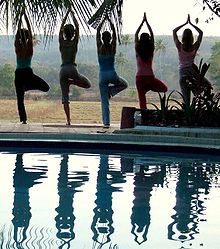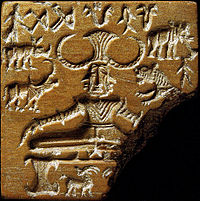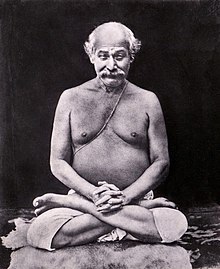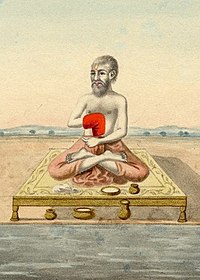Yoga
![]()
This article is about yoga, the Indian doctrine of mental and physical exercises. For the Western-style Japanese painting of the same name, see Yōga.
Yoga - formerly also spelled yoga - (Sanskrit योग IAST yoga masculine; from yuga 'yoke', yuj for: 'to yoke, bind together, harness, harness') is a philosophical doctrine originating in India, comprising a series of mental and physical exercises or practices such as yama, niyama, asanas, pranayama, pratyahara, kriyas, meditation and asceticism. The term yoga can mean "union" or "integration" as well as in the sense of "harnessing" (cf. "yoking") and "straining" the body to the soul for collection and concentration or for becoming one with consciousness. Since every path to self-knowledge can be called yoga, there are numerous names for the different yoga paths in Hinduism, which are adapted to the respective dispositions of those striving for self-knowledge.
Yoga is one of the six classical schools (Darshanas) of Indian philosophy. There are many different forms of yoga, often with their own philosophy and practice. In Europe and North America, until recently, the term yoga was often understood to mean only physical exercises - the asanas or yogasanas - and the term was thus largely equated with hatha yoga.
Some meditative forms of yoga focus on mental concentration, others more on physical exercises and positions as well as breathing exercises (pranayama), other directions emphasize asceticism. The philosophical foundations of yoga were summarized primarily by Patanjali in the Yogasutra; the Bhagavad Gita and the Upanishads also provide information about yoga.
Yoga as taught in the West is based on a modern form that emerged from the mid-19th century, often characterized by an adoption of Western esoteric ideas, Western psychology, physical training, and scientific assumptions by English-speaking and Western-educated Indians. In these cases, modern yoga represents a New Age approach to life rather than a form of Hindu spirituality. Traditional, Indian yoga is fundamentally different from Western, modern yoga and contains much more complex teachings and practices than the modern forms.
The yoga practitioner and especially a master of yoga is called Yogī or Jogi (Sanskrit योगी) or Yogin (योगिन्). The feminine form is Yoginī (योगिनी), which however also means "sorceress" (see Yogini).
On December 1, 2016, yoga was recognized as a UNESCO Intangible World Heritage Site.

Yoga exercise in the group
History
Already the older Upanishads (ca. 700 B.C.) describe breathing exercises and the withdrawal of the senses (Pratyahara) into the Atman as an aid to meditation (Dhyana). The middle Upanishads, which originated around 400 B.C., mention the term yoga several times and also the essential elements of the later yoga system. Yoga was closely connected with the theories developed by the philosophical system of Samkhya and formed its practical continuation.
In the Indian epic Mahabharata around 300 BC, yoga already occupies an important place and is mentioned as a practical counterpart to the theoretical Sânkhya. While in the Mahabharata and in the older Puranas the sage (rishi) Kapila and others are mentioned as the founders of Yoga, Patanjali appears at this place in more recent Puranas. However, it may be assumed that Patanjali summarized the traditional yoga teachings from the period between the 2nd century BC and the 4th century AD. His work consists of 194 short mnemonic sayings (sutras) spread over four books.
The classical Indian scriptures describe four yoga paths:
- Raja Yoga is the name given to the meditation-oriented stages of the eight-limbed yoga according to Patanjali (also called Ashtanga Yoga: "Ashta" = eight, "Anga" = parts).
- Jnana Yoga (Yoga of knowledge, intellectual direction)
- Karma yoga (yoga of action, selfless action)
- Bhakti yoga (yoga of love/worship/ devotion to God or an Ishtadevata)
The fifth major yoga path, established between the 13th and 14th centuries, is hatha yoga (yoga of power or momentum).
In addition, the following systems can be added:
- Mantra Yoga
- Laya Yoga
- Kundalini Yoga
Originally, yoga was a purely spiritual path that primarily aimed at the search for enlightenment through meditation. The many asanas only developed over time. Their primary goal is to strengthen and mobilize the body in such a way that it can remain in the meditation seat - e.g. lotus seat - for a longer period of time without discomfort. Over time, the positive effect of the physical exercises on the overall well-being of the person was increasingly recognized. The Asanas were further developed, and physical exercise in yoga is becoming more and more important in our time. This development was first reflected in the emergence of Hatha Yoga. The "Hathapradipika", a 15th century text, sets out the techniques that incorporate the body as an effective means of achieving the existential and spiritual goals of yoga.
After Vasco da Gama had discovered the sea route to India in 1498, the Portuguese conducted trade business, but largely refrained from Christian missionary attempts. The missionaries who came to India from 1539, initially in the form of Jesuit monks from Portugal, rejected yoga as a manifestation of Hinduism and thus as pagan. Starting from Goa, the "capital of Christianity in Asia", all Indians living under Portuguese rule had to turn to the Christian religion by 1774. English colonial rulers (1756-1947) were also not very open to yoga. Yoga was seen as a part of Indian culture to be replaced with English values. British missionaries spread Anglican or other Protestant denominations. The day of yoga is celebrated on June 21.

The "Mohenjo-Daro Seal 420" from the heyday of the Bronze Age Indus civilization, the central figure shows an ithyphallic figure on a throne in a sitting posture with the heels touching and the toes pointing downwards.

Lahiri Mahasaya (1828-1895) in the lotus position. Photo from the book by Paramahamsa Yogananda "Autobiography of a Yogi".

Kapila, a sage from the mythology of the Vedic civilization, is considered the originator of Bhakti Yoga. Watercolour from the 19th century.
Yoga Philosophy
Roots
Since yoga originated in India, the roots of yoga philosophy lie in Hinduism and parts of Buddhism. The individual is seen here as a traveller in the chariot of the material body. The chariot is the body, the coachman the mind, the five horses the five sense organs, the passenger the soul, and the harness is called "yoga" in Indian. The oldest records are found in the Upanishads. The most important source text of Yoga is the Yoga Sutra of Patanjali.
To illustrate, the first four Sūtras of Patanjali, which give the core of yoga and are a kind of mantra, are as follows.
- atha yoga-anusäsanam; translated, this means: Now (follows) the discipline of Yoga. What is meant is a kind of absolute now, for things of the past, their essence, be they habits, are to be cast off. This likewise means traditions. "But it is a fact that Yoga is opposed to the conventional meaning of words. It even rejects past experiences and their verbalization (I 15)." The rationale for this is found in the 4th Sūtre.
- yogas citta-vrtti-nirodhah; meaning: Yoga is that inner state in which the mental-spiritual processes come to rest. Nirodah refers to the slowing down and pausing of the vortical movements (vṛtti) in our bodily existence (citta, in the sense of embodied mind).
- tadä drastuh svarüpe'vasthänam; meaning: then the seeing person rests in his essential identity, or also: then the seeing principle (draṣṭuḥ) - which is inherent in each of us - takes its place in his essential nature (svarūpe, empty self-form).
- vrtti-särüpyam itaratra; meaning: All other inner states are determined by the identification with the mental-spiritual processes: "If one is still attached to the past, from which one projects hope for the future, one will never be able to establish a meaningful relationship with yoga". The term vritti refers to "an activity that takes place in the fixed channels of habit and convention and is therefore attached to the past".
Bhagavad-Gita
The chapter titles in the Bhagavad-Gita each indicate a particular form of yoga, for example Karma-Yoga or Jnana-Yoga. They provide the practitioner with important philosophical-spiritual background for the understanding of yoga. Among other things, they contain ethical teachings that clarify the Yamas and Niyamas. The text deals with karma - the Hindu and Buddhist principle of cause and effect - reincarnation, meditation, dharma, self-knowledge and faith-based love. The text often uses figurative representations. Thus, the hostile relatives who are to fight Arjuna can be interpreted as a symbol of the kleshas from which the yogi (the one who practices yoga) is to purify himself.
Moreover, the Bhagavad-gita contains direct instructions for the follower of yoga, i.e. for the yogi. Thus, in the 5th chapter it says: "Detaching from the outer world, looking fixedly at the root of the nose (nasikagra) - Regulating like the breath and exhalation (inhalation/exhalation) that pass through the nose within." (Verse 27)
Verse 28 turns to spiritual goals: "Restraining the senses, heart and mind, wholly turned to salvation - Freed from desire, fear and anger, so forever he is redeemed."
Chapter 6 is about immersion (dhyana) and the right way of life:
In verse 10, it says, 'The yogi should constantly toil in solitude - alone, taming mind and self, hoping for nothing, without possessions'.
Verses 11-13 of chapter 6 contain instructions for sitting posture and even for the seat. 12 "Keeping the mind fixed on one point, restraining thought, senses and action - Sitting down on the seat, let him practice devotion for the purification of himself. 13 Keeping body, neck, head steady, he remains firm - Looking at the root of his nose, he does not look out here and there".
Verses 33-34 deal with religious concepts. Arjuna suggests that the mind is as difficult to control as the wind, and Krishna replies that the mind can be disciplined by effort and renunciation. Then Arjuna asks what about the people who cannot restrain themselves, whether they are lost forever. Krishna consoles him by pointing to reincarnation as another chance to achieve samadhi.
Questions and Answers
Q: What is yoga?
A: Yoga is an old discipline of Hindu philosophy from India that combines spiritual and physical practices such as breathing techniques, exercise and meditation to help improve health and happiness.
Q: What does the Sanskrit word for yoga mean?
A: The Sanskrit word for yoga means "union".
Q: Who was a pioneer of classical yoga?
A: Patanjali was a pioneer of classical yoga.
Q: What did Patanjali define yoga as?
A: Patanjali defined yoga as "the cessation of the modification of the mind" (stopping changing the mind).
Q: What are some aspects important in yoga?
A: Some aspects important in yoga include breath-work, mantras, mudras (postures of the hands and fingers), meditation and more.
Q: What is the sun salutation? A: The sun salutation is a sequence of 12 poses called asanas that are said to help balance body and soul. There is a specific mantra for each asana. This sequence is also known as Suryanamaskar.
Search within the encyclopedia